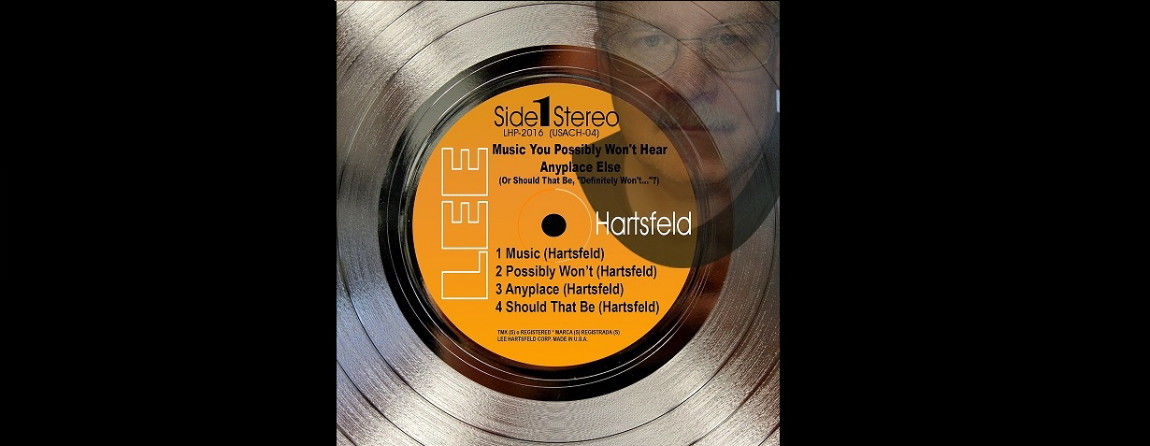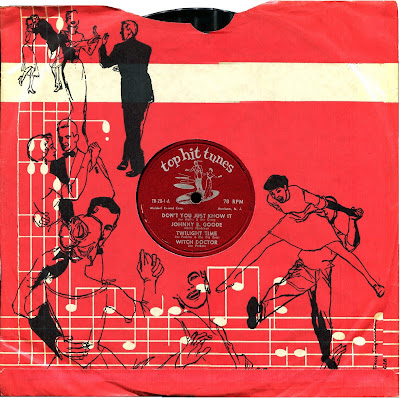A cheap-looking but fairly effective jacket photo, with the guy on the left either badly sunburned or wearing war paint. (Sorry, that was not PC.) The extreme contrast was not my doing. It seems to have happened only in the upper left hand corner, and I suspect a lighting issue during the shoot. Since this release is the cheapest of the cheap (Halo, a product of the fake RCA--aka, Record Corp. of America), we can naturally expect the soda bottles on the cover to not be part a product plug--no respectable soda brand would have wanted a shout out on one of these. And so the bottles are generic. And they may not even contain pop. (I'm not suggesting whiskey or anything else alcoholic, but who knows?) And I have no idea what's going on with the jacket's catalog number (50220X), since the number on the labels is 1670--the standard number for this outfit's Tops in Pops albums. (Earlier on, the standard fake-RCA catalog number was 1389.) Like Tops, the fake RCA used a single catalog number for its fake-hits albums, plus a system of suffixes that made absolutely no sense, because there was no consistency to them. None. Zilch. I've concluded the cheapies weren't trying for consistency. Consistency involves planning. Planning takes time. Time is money.
Anyway, I ripped this according to the track order on the jacket, which makes the terrific I Got Stung our fourth offering. Having it near the start really helps moves thing along--that was my main motivation for going with the jacket listing. In fact, the label suffixes--W and X--suggest that the second row of titles should be regarded as Side 1, but there's really no way to be sure. All Halo would have had to do was print "Side 1" and "Side 2" on the labels, but more ink means more money, and I seriously doubt Halo cared which side people played first. Halo didn't care if you tossed this to your dog for a game of fetch.
I love the top line, all in the same font and looking like something spit out of a teletype machine: "ultraphonic high fidelity...........Tops in Pops.....longplay." Who in his or her right mind would have believed this LP actually includes "All the latest hit recordings"? Which is one bold (as in, blatantly false) claim. We have to hope that no one mistook this for a legit issue. How would that be possible? We have the label name stuck down in the yellow rectangle that served as the title box (I've found three other versions which sport this cover), and the cheap print isn't even properly centered (notice how "Donna" and "Near You" spill over the bottom line). Meanwhile, the models are shoved to the edges of the pic. I guess I need to revise my "fairly effective jacket" verdict. It is fairly effective--until you analyze it in detail.
Given all these crimes against the purchaser, the tracks must be pretty bad, no? Actually, they're terrific. I can't explain it, but I don't complain. The performers put their all into these numbers, and the difference between this group of fakes and the lackluster Tops material of three posts back (the girl with the loud socks) is pretty epic. These are genuinely fine fakes. I guess we can forgive the lousy lettering and deranged numbering system, though we can still make fun of them.
Masterful fakes of the Playmates' Beep Beep, the Big Bopper's Chantilly Lace, Bobby Darin's Queen of the Hop, Little Anthony and the Imperials' Tears on My Pillow, Warren Covington's delightful Tea for Two Cha Cha, and, of course, I Got Stung--one of the best budget fakes ever. We owe "Unknown" a long and heartfelt round of applause.
Oh, and the sound quality is surprisingly good, too. This LP was an accident or something.
DOWNLOAD: Tops in Pops (Halo 50220X; prob. 1958)
Lee































